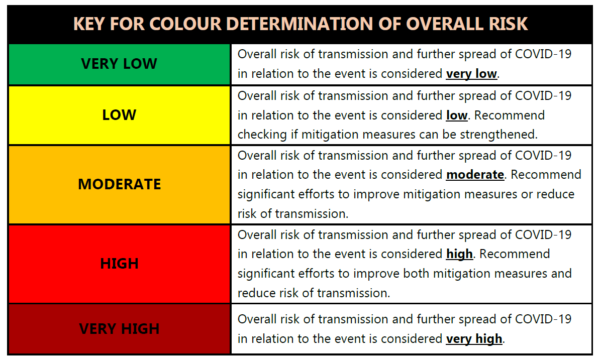After the nationwide lockdown was instated, many long-awaited events were cancelled to abide by regulations. The Event Safety Council (ESC) has now announced a number of new guidelines for event organisers to follow in coming months.
“We understand the control measures needed, that they be consistent with the overall national strategies and policies, recognise global best practice in minimising the spread of COVID-19, thus, protecting workers, staff, attendees and the public whilst attending events,” said the Event Safety Council in a statement.
“The South African event community understands that events and gatherings have a direct effect on the transmission of COVID-19 from person to person. By developing and adopting best practises guidelines throughout the events industry as a whole, we believe will provide a level of comfort to the Government of South Africa and the South African public that reasonably practicable processes are in place to protect persons against the spread and exposure to COVID-19 at events.”
The aim of the newly released guidelines is to prepare organisers for arranging events to the best of their ability in future by ensuring the safety of their attendees and encouraging new safe habits.
ESC worked with a number of global partners to develop the guidelines including the Southern African Association for the Conference Industry (SAACI).
A COVID-19 prevention strategy
To successfully host an event, the organisers must have a COVID-19 prevention strategy that includes:
– Risk assessment based on the hazard COVID-19 poses
– Provide an understanding of the different types of exposure risk along the event chain
– Who may be exposed and how this exposure could happen
– Outlining plans for high-risk individuals
– Hierarchy of controls required in line with the Department of Employment and Labour (DoEL) and Department of Health (DOH) requirements for COVID-19
– Providing key control measures based on national legislation and global best practices
– Information and communication strategy
– Training and awareness protocols
– Staff management protocols
– Attendee management protocols
– Cleaning and hygiene protocols
– Venue management protocols
– Safe operating procedures and practices around issues such as load-in and load-out, transport, food service, waste, etc.
– Roles and responsibilities
– Stakeholder & role-player engagement
– Provide health and safety documentation included in the event safety plan (section 4, SASREA) with respect to COVID-19 preventative measures for the event.
A risk assessment process
An employer is required by new guidelines to review and update their risk assessment to cover any changes in the workplace environment.
An event organiser is required to carry out a risk assessment outlining the hazards and associated risks to COVID-19 will have at an event. The risk assessment must cover the people that may be exposed and infected and how this exposure may happen. Included in the assessment is the control measures that will be implemented, the persons responsible in the implementation of the control measures, and any additional steps required to minimise the impact COVID-19 will have on the health of staff, workers, and attendees to the event.
Guidelines recommend that before an event is approved or is presented to the appropriate authorities, that a risk assessment is drawn up detailing the risk profile specific to the event based on:
1 – Very low-risk exposure events: When an event has a low or minimal chance of transmitting the COVID-19 virus and basic principles applied to minimise exposure.
2 – Low-risk exposure events: When an event has limited exposure and unlikely to expose attendees to risk and can be easily controlled with adequate and approved planning processes in place as part of the Event Safety Plan.
3 – Moderate risk exposure events: When there is more than likely the probability of exposure to COVID-19 virus at the event, detailed plans and processes are needed to minimise and manage the exposure risk. These detailed COVID-19 plans should be planned with all role-players making up the event safety and security planning committee (ESSPC) in approving the health protocols for the event.
4 – High-risk exposure events: When there is greater potential of exposure and detailed and rigorous planning is needed in order to host the event. Planning with the ESSPC role-players is critical in determining the risks and the measures needed to mitigate these risks and outlining the roles and responsibilities in curbing potential spread.
5 – Very high-risk exposure events: When the likelihood of transmission to many people is probable and requires careful consideration and planning by all role-players making up the ESSPC in determining the required measures needed in protecting those working or attending the event. Full approvals processes will need to be in place managing health concerns before the event can go ahead.
COVID-19 control procedures will be required to include FEDHASA Safety Guidelines.
Hierarchy of controls
The hierarchy of controls and principals of prevention should be applied, including:
– Eliminate or physically remove the hazard or source of the hazard;
– Substitution such as replacing something that minimises the risk of exposure;
– Engineering controls such as isolation in reducing the potential to exposure;
– Administrative controls such as changing the process in reducing the exposure;
– Personal Protective Equipment (PPE) worn to minimise exposure to a hazard that may cause illness
Event organisers will be required to consider and implement key control measures, operational measures, role and responsibility measures and be aware of risk levels associated with their event:

Communication and contact tracing will also be required from event organisers. A total of 73 pages of guidelines have been published that event-goers and organisers should review before attending or arranging an event post COVID-19:
Read the full guidelines here: Event Safety Council Re-Opening Guidelines version 1
Picture: Pexels

